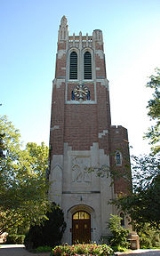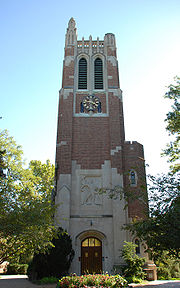
Beaumont Tower
Encyclopedia

Michigan State University
Michigan State University is a public research university in East Lansing, Michigan, USA. Founded in 1855, it was the pioneer land-grant institution and served as a model for future land-grant colleges in the United States under the 1862 Morrill Act.MSU pioneered the studies of packaging,...
. The 104 feet (31.7 m) tower marks the site of College Hall
College Hall (Michigan State University)
College Hall was the first building erected on the campus of the Agricultural College of the State of Michigan , and the first in the United States to be erected "for the teaching of scientific agriculture." Reputedly designed by John C...
, the first building in America erected for instruction in scientific agriculture
Agriculture
Agriculture is the cultivation of animals, plants, fungi and other life forms for food, fiber, and other products used to sustain life. Agriculture was the key implement in the rise of sedentary human civilization, whereby farming of domesticated species created food surpluses that nurtured the...
.
During its dedication ceremony the president of the college described Beaumont Tower as "a meeting or trysting place of the students, student groups or organizations, the center of all the activities of this institution."
The tower is also the meeting place for the executive board of the Michigan State University Tower Guard. The Tower Guard is MSU’s oldest and one of the most respected student organizations on campus. Tower Guard, founded in 1934 by May Shaw, the wife of former MSU president Robert Shaw, was originally a female honor society that was a service oriented organization which would help to serve the needs of visually impaired students at Michigan State University. In 1977, membership was opened to the outstanding young men on campus in addition to women. Each year, the top sophomores are chosen to carry on the tradition based on their academic excellence, leadership, outstanding character, and commitment to service.
The tower features The Sower, an Art Deco
Art Deco
Art deco , or deco, is an eclectic artistic and design style that began in Paris in the 1920s and flourished internationally throughout the 1930s, into the World War II era. The style influenced all areas of design, including architecture and interior design, industrial design, fashion and...
bas-relief by sculptor Lee Lawrie
Lee Lawrie
Lee Oscar Lawrie was one of the United States' foremost architectural sculptors and a key figure in the American art scene preceding World War II...
(1922), with its inscription, "Whatsoever a Man Soweth" (from Galatians
Epistle to the Galatians
The Epistle of Paul to the Galatians, often shortened to Galatians, is the ninth book of the New Testament. It is a letter from Paul of Tarsus to a number of Early Christian communities in the Roman province of Galatia in central Anatolia...
6:7). This serves as a tribute both to MSU's origins as an agricultural college and to the seminal nature of knowledge.
Beaumont also houses a full carillon
Carillon
A carillon is a musical instrument that is typically housed in a free-standing bell tower, or the belfry of a church or other municipal building. The instrument consists of at least 23 cast bronze, cup-shaped bells, which are played serially to play a melody, or sounded together to play a chord...
, with 49 bells. Free concerts on the lawn are available in the summer. Beaumont Tower is one of the most recognizable and most photographed landmarks on the MSU campus. Its likeness as a line drawing is used on MSU letterhead.
The northeast finial
Finial
The finial is an architectural device, typically carved in stone and employed decoratively to emphasize the apex of a gable or any of various distinctive ornaments at the top, end, or corner of a building or structure. Smaller finials can be used as a decorative ornament on the ends of curtain rods...
is higher than the other three. The missing finials represent the need for higher education.
The most popular traditions surrounding Beaumont Tower involve kissing, either in the shadow of the tower during the day, or at midnight in the Beaumont courtyard, to prove one is a "true Spartan." It is said that a Spartan is destined to marry a sweetheart if they kiss under Beaumont Tower.
External links
- The Greater Lansing Convention & Visitors Bureau
- Beaumont Tower - a short CNNCNNCable News Network is a U.S. cable news channel founded in 1980 by Ted Turner. Upon its launch, CNN was the first channel to provide 24-hour television news coverage, and the first all-news television channel in the United States...
article - Beaumont Tower: At the Crossroads of Past, Present & Future - MSU Alumni Association article
- M.A.C. - College Hall
- MSU Tower Guard

